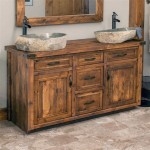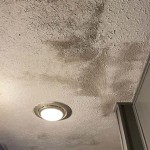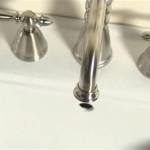How To Hide Pipes Behind a Bathroom Sink Drain
Exposed pipes beneath a bathroom sink, while functionally necessary, can detract from the overall aesthetic of the space. Fortunately, several methods exist to conceal these pipes, enhancing the bathroom's visual appeal without compromising functionality. This article provides a comprehensive guide on how to hide pipes behind a bathroom sink drain, covering various approaches and their respective considerations.
Planning and Assessment: Determining the Best Approach
Before undertaking any pipe-hiding project, a thorough assessment of the existing plumbing configuration is crucial. This involves identifying the type of pipes (e.g., PVC, copper), their dimensions, and their proximity to the wall and floor. Furthermore, consider the frequency of access required for potential repairs or maintenance. A clear understanding of these factors will dictate the most suitable concealment method.
Accessibility is a paramount consideration. Concealing pipes should not impede future maintenance or repairs. Ideally, the chosen method should allow for easy removal or access panels should be incorporated for regular inspection and any necessary plumbing work. Neglecting this aspect can result in costly and disruptive interventions in the future.
The overall bathroom design aesthetic must also be taken into account. The concealment method should complement the existing style and colors of the bathroom. For example, a modern bathroom might benefit from a sleek, minimalist vanity, while a more traditional bathroom could incorporate a decorative cabinet. Selecting a concealment option that harmonizes with the bathroom's design will ensure a cohesive and visually appealing result.
Finally, budget considerations play a significant role. Some pipe-hiding solutions are more expensive than others. Custom vanities, for instance, require a larger investment than simply installing a pedestal sink skirt. Carefully evaluate the costs associated with each option and choose a solution that aligns with your financial constraints.
Vanity Installation: The Most Common Solution
Replacing an existing pedestal sink with a vanity is often the most effective method for concealing pipes. Vanities offer ample storage space while completely enclosing the plumbing. Various styles and sizes are available to suit different bathroom dimensions and design preferences.
When selecting a vanity, carefully measure the available space to ensure a proper fit. Consider the placement of the drainpipe and water supply lines to avoid any interference with the vanity's installation. Most vanities come with pre-cut openings for plumbing access, but modifications may be necessary depending on the specific configuration.
Installation typically involves disconnecting the existing plumbing, removing the old sink, and assembling the new vanity. Secure the vanity to the wall studs for stability and connect the drainpipe and water supply lines. Ensure all connections are watertight to prevent leaks.
Different vanity types offer varying levels of concealment and storage. A full vanity with doors and drawers provides the most comprehensive coverage, while an open-shelf vanity offers a more minimalist aesthetic while still providing some level of pipe blockage. Consider the desired level of concealment and storage capacity when making your choice.
Beyond standard vanities, custom-built options provide the highest degree of design flexibility. A custom vanity can be tailored to precisely fit the available space and accommodate any unique plumbing configurations. While more expensive, custom vanities offer a bespoke solution that seamlessly integrates with the bathroom's overall design.
Pipe Covers and Wraps: A Simple and Affordable Alternative
For those seeking a less involved solution, pipe covers and wraps offer a simple and affordable way to conceal exposed pipes. These products come in various materials, such as plastic, metal, and fabric, and can be easily installed without requiring extensive plumbing modifications.
Pipe covers typically consist of two halves that snap together around the pipes, creating a seamless and aesthetically pleasing enclosure. They are available in a range of colors and finishes to match the existing bathroom decor. Measure the diameter of the pipes to ensure you select the correct size of pipe cover.
Pipe wraps, on the other hand, are flexible materials that are wrapped around the pipes and secured with adhesive or fasteners. They are particularly useful for concealing irregularly shaped or angled pipes. Fabric pipe wraps can add a decorative touch to the bathroom, while metal wraps offer a more industrial aesthetic.
Installation of pipe covers and wraps is generally straightforward, requiring only basic tools such as a measuring tape, saw (for cutting covers to length), and adhesive (if needed). Follow the manufacturer's instructions carefully to ensure a secure and aesthetically pleasing result.
While pipe covers and wraps are a cost-effective solution, they may not provide the same level of concealment as a vanity. They are best suited for situations where only a partial concealment is desired or where budget constraints are a primary concern. Also, be aware that some options may require careful cleaning and maintenance to remain visually appealing.
Creative Solutions: Thinking Outside the Box
Beyond the standard options, several creative solutions can be employed to conceal pipes behind a bathroom sink drain. These approaches often involve repurposing existing materials or incorporating decorative elements to camouflage the plumbing.
One popular option is to create a decorative screen or panel to hide the pipes. This can be accomplished using various materials, such as wood, metal, or fabric. The screen can be mounted to the wall or floor and designed to complement the bathroom's overall aesthetic. Lattice panels, for example, can provide a visually appealing and semi-transparent screen.
Another creative solution is to incorporate plants into the bathroom design. Strategically placed potted plants can effectively conceal pipes while adding a touch of greenery to the space. Choose plants that thrive in humid environments and require minimal maintenance.
Painting the pipes to match the wall color is a simple yet effective way to minimize their visual impact. This approach is particularly useful in bathrooms with a minimalist or monochromatic design. Choose a paint that is specifically designed for use on metal or PVC pipes.
Repurposing old furniture or decorative items can also offer a unique way to conceal pipes. For example, an old wooden crate can be modified to serve as a pipe cover, adding a rustic and charming touch to the bathroom. Consider the existing décor and choose materials that complement it to achieve a cohesive look.
Finally, consider the use of decorative baskets. Baskets can be placed strategically to hide the pipes while also providing additional storage for toiletries or other bathroom essentials. Choose baskets that are made from natural materials such as wicker or seagrass to add a touch of texture to the bathroom.
Plumbing Considerations: Protecting and Maintaining Access
Regardless of the chosen method, it's essential to consider the implications for plumbing maintenance and accessibility. Concealing pipes should not compromise the ability to inspect, repair, or replace them in the future.
If using a vanity or cabinet, ensure that there is adequate access to the drainpipe and water supply lines. This may involve creating access panels or leaving sufficient space behind the vanity for plumbing work. Consider incorporating a removable back panel for easy access to the pipes.
When using pipe covers or wraps, choose materials that can be easily removed or reinstalled without damaging the pipes. Avoid using adhesives that are difficult to remove or that could potentially corrode the pipes.
Regularly inspect the concealed pipes for leaks or other signs of damage. Early detection of problems can prevent costly repairs and water damage. Consider installing a water leak detector to provide an early warning of any plumbing issues.
If you are not comfortable working with plumbing, it is best to consult with a qualified plumber before undertaking any pipe-hiding project. A plumber can assess the existing plumbing configuration and recommend the most appropriate concealment method while ensuring that all plumbing codes are met.
Consider the materials used in the concealment itself. Ensure they are water-resistant or waterproof to prevent damage from condensation or leaks. Materials like MDF, if not properly sealed, can quickly degrade in a humid bathroom environment.
Lighting Considerations: Highlighting or Hiding
The lighting in your bathroom can play a crucial role in either highlighting or further concealing the pipes. Strategic lighting can draw attention away from the concealed pipes or even enhance the aesthetic of your chosen concealment method.
If opting for a vanity, consider installing under-cabinet lighting. This can illuminate the floor area beneath the vanity and create a sense of spaciousness, diverting attention from the pipes themselves. LED strip lights are a popular choice for under-cabinet lighting due to their energy efficiency and long lifespan.
Conversely, avoid placing direct lighting near the concealed pipes, as this can cast shadows and draw attention to any imperfections in the concealment. Instead, focus on creating ambient lighting that illuminates the entire bathroom evenly.
If you have chosen a creative concealment method, such as a decorative screen or plant arrangement, consider using accent lighting to highlight these features. This can draw the eye away from the pipes and create a more visually appealing focal point.
The color temperature of the lighting can also affect the overall aesthetic. Warm white lighting creates a cozy and inviting atmosphere, while cool white lighting provides a more modern and clean look. Choose a color temperature that complements the bathroom's overall design and enhances the chosen concealment method.
Finally, consider the use of dimmer switches to control the intensity of the lighting. This allows you to adjust the lighting to suit your mood and create a more relaxing and inviting bathroom environment. This can also help to minimize the visibility of the concealed pipes by reducing the overall brightness in the area.

Boxing In Bathroom Pipework Guru

Ask A Builder Hiding Pipes

How To Hide Pipes On A Small Floating Si Bunnings Work Community

How To Hide Plumbing In Your Bathroom Victoriaplum Com

Pin On Layouts

Pin On Bathroom

5 Ways To Conceal A Waste Pipe Under Vanity The Plumbette

How To Hide Plumbing Behind A Pedestal Sink R S Andrews

Help Hiding Pipes In Downstairs Toilet Houzz

9 Creative Ways To Hide Pipes Under Bathroom Sinks Homes On Point
Related Posts







